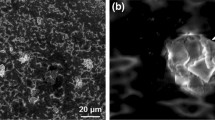5
C) alloy thin films grown by plasma-enhanced chemical vapor deposition have been examined. The Ni-doped boron–carbon alloys were grown using closo-1,2-dicarbadodecaborane (C2B10H12) as the boron–carbon source compound and nickelocene(Ni(C5H5)2) as the nickel source. The phosphorus-doped alloys were grown using the single-source compound: dimeric chloro-phospha(III)-carborane ([C2B10H10PCl]2). Nickel doping increased the conductivity, relative to undoped B5C, by six orders of magnitude from 10-9 to 10-3 (Ω cm)-1 and transformed the material from a p-type semiconductor to an n-type. Phosphorus doping decreased the conductivity, relative to undoped B5C, by two orders of magnitude and increased the band gap from 0.9 eV for the undoped material to 2.6 eV. Infrared absorption spectra of the nickel- and phosphorus-doped B5C alloys were relatively unchanged from those of undoped B5C. X-ray diffraction suggests that the phosphorus-doped material may be a different polytype from the Ni-doped and undoped B5C alloys.
Similar content being viewed by others
Author information
Authors and Affiliations
Additional information
Received: 23 April 1997/Accepted: 3 November 1997
Rights and permissions
About this article
Cite this article
McIlroy, D., Hwang, SD., Yang, K. et al. The incorporation of Nickel and Phosphorus dopants into Boron-Carbon alloy thin films . Appl Phys A 67, 335–342 (1998). https://doi.org/10.1007/s003390050780
Issue Date:
DOI: https://doi.org/10.1007/s003390050780




